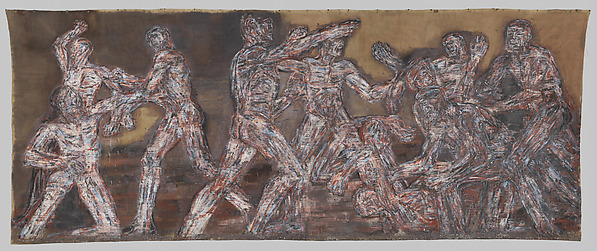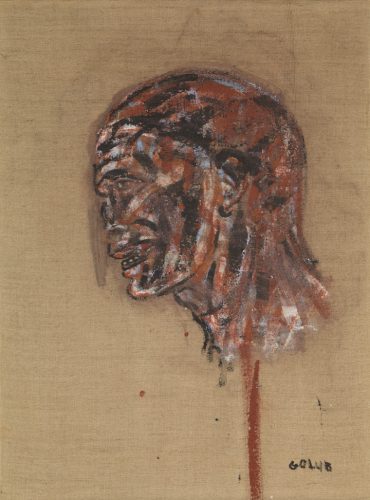
Leon Golub, “Gigantomachy II,” acrylic on linen, 1966 (The Metropolitan Museum of Art, New York, Gift of The Nancy Spero and Leon Golub Foundation for the Arts and Stephen, Philip, and Paul Golub, 2016. Art © The Nancy Spero and Leon Golub Foundation for the Arts/Licensed by VAGA, New York, NY)
The Met Breuer
945 Madison Ave. at 75th St.
Through May 27, suggested admission $12-$25
212-535-7710
www.metmuseum.org
The outstanding Met Breuer retrospective “Leon Golub: Raw Nerve” is meant to touch a raw nerve, and it does. In his primarily figurative, often large-scale works, the Chicago-born artist focused on the brutal side of humanity, exploring violence, hatred, bigotry, torture, cruelty, and war. He would even attack the canvases themselves, scratching and scraping at them, at times using a meat cleaver. When visitors get off the elevator, they are suddenly face-to-face with Golub’s “Gigantomachy II,” a ten-foot-by-twenty-four-foot acrylic painting on linen of a group of men fighting, their skin flayed from their bodies; the title evokes the battle between the Greek Gigantes and Olympian gods. Golub, who was married to artist and activist Nancy Spero for nearly fifty years, often used classical and art-historical imagery in his works; he also kept an archive of clippings from newspapers and magazines to use as reference. The riveting show, which is meant to jolt viewers, to shock them into action, features works from such series as “White Squad,” “Interrogation,” “Horsing Around,” “Napalm,” and “Pylons,” with the vast majority of his subjects being male, although he occasionally includes women. In the disturbing “Horsing Around IV,” a white man holding a bottle of alcohol exposes the breast of a black female prostitute. In “Two Black Women and a White Man,” two black women are sitting on a bench while a white man to their left leans against a wall, his hands in his pocket, looking away, trying to avoid them or pretend they’re not there. The wall behind the women is a light color, while the wall behind the man is blue; Golub slyly has the hand of one of the women casually lean over into the blue frame, gently infringing on his fear.

Leon Golub, “Vietnamese Head,” acrylic on linen, 1970 (The Metropolitan Museum of Art, New York, Gift of Dan Miller, in loving memory of the artist, 2016. Art © The Nancy Spero and Leon Golub Foundation for the Arts/Licensed by VAGA, New York, NY)
Other works depict skeletons, angry dogs, men with rifles, a woman in an S&M-like mask surrounded by blood, and a quartet of portraits of Brazilian president and general Ernesto Geisel as he ages and loses his power. In a 1996 catalogue statement reprinted in the 1997 book Do Paintings Bite?, Golub, who passed away in 2004 at the age of eighty-two, wrote, “The history of the twentieth century is in large part a record of war, violence, and atrocities. This is not of course the only history which is recorded but nevertheless it is extraordinary in both its virulence and in its widespread extensions. . . . Despite the apparent pessimism of negativity of the subject matter in the very reportage, in the very reporting of all this, there is retained a residual optimism in the very freedom to tell, that is to make and exhibiting these paintings.” The Met Breuer exhibit ably displays that sentiment, revealing an artist who was determined to face the violence in contemporary society head-on through daring works of art that attempt to force viewers out of their complacency and realize what is happening all around them.